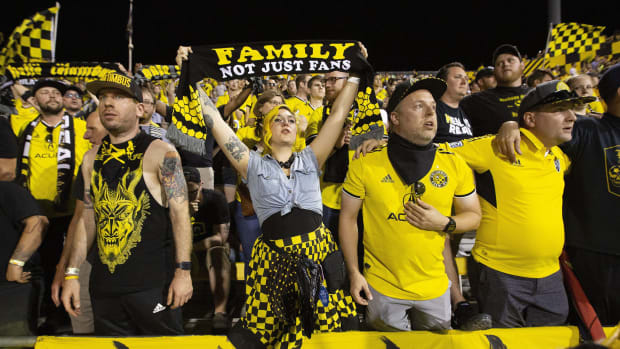The Crew's rebrand lasted all of a week, with the club hearing the backlash and taking swift action to restore the name the fans didn't want changed in the first place.
The Columbus Crew—yes, that’s Crew—are suffering from a bit of an MLS Cup hangover. It's started the 2021 season with just one win in its first five MLS games and was knocked out of the Concacaf Champions League quarterfinals.
Coach Caleb Porter’s squad remains immensely talented. The hangover is a short-term problem. Meanwhile, and thankfully for the club, the long-term prospects remain bright. That’s because its fans and supporters groups have suffered no letdown. They’re in championship form.
Emboldened by their success in preventing the Crew’s potential move to Austin and in attracting new ownership, and then strengthened by the infrastructure, methodology and relationships that made that victory possible, Columbus fans are a force to be reckoned with. It took them only a week to compel the club and its new owners, Dee Haslam and Dr. Pete Edwards, to walk back a rebrand they’d spent many months preparing.
Columbus SC lasted one game. Late Monday night, the team, in conjunction with the Nordecke supporters’ group, announced the return of the Crew name (and the erasure of the SC suffix entirely). It’s not a complete reversal. The new pennant logo featuring a large C, which is a deep downgrade from the popular and distinctive circular crest introduced in 2015, will remain and be slightly altered. But for most Columbus fans, it was the name that was vital. 'Crew' has roots dating back a quarter century. It adorned the jerseys of two championship teams and is a thread that runs through every era of the club’s history. It’s the original name of MLS’s original team. Columbus supporters saved the Crew two years ago, and then they saved it again.
“We’re going to be the Columbus Crew, and we’re going to be the Columbus Crew forever,” Edwards said in a video statement released by the club.
Ownership’s quick response to the outcry suggests that the attempted rebrand was clumsy and incompetent, not arrogant or ego-driven. The initiative was conducted without fan consultation or feedback. Two Nordecke officials who then were shown the new branding submitted a comprehensive response to the club that was ignored. The timing of the rebrand, which came just a few weeks into the new season—the Crew was still enjoying that championship afterglow while preparing to open a new stadium in early July—ground the positive momentum to an infuriating halt.
Haslam and Edwards quickly acknowledged that the process was poor. Shortly after the rebrand was unveiled, they released a statement to The Columbus Dispatch saying, in part, “Clearly, this process was not aligned with how we intend to operate. The feedback from representatives of the Nordecke was not elevated and discussed at the appropriate level or incorporated enough into our process. … We will turn our focus to creating substantive and meaningful dialogue with the Nordecke on moving forward together.”
And they did that. Following a Monday meeting that included Haslam, Edwards, Crew president and GM Tim Bezbatchenko and several fan representatives, the club not only announced the restoration of the name but pledged to create a supporters’ liaison position in the club’s front office and to meet regularly with fans.
The entire episode was totally unnecessary. No rebrand was needed. But it seems to have ultimately strengthened the ties between the team and the city while serving as a valuable learning experience for ownership. It also demonstrated the influence and impact that a smart, well-organized fan base can have.

“The ownership group’s willingness and desire to meet with supporters … is really setting itself apart, from not just the rest of MLS but sports in the United States,” Nordecke board member Jeff Barger said. “It’s a huge commitment. It’s one they’re serious about, and I think that it’s going to help us chart a path forward together that is what we always hoped.”
It’s interesting and somewhat unexpected that in this era of entrenched income inequality, during which an increasing amount of our sports and culture seems to fall under the sway of a decreasing number of multibillionaires, that fans in a few places have found a way to bridge that disconnect and effect change. The spontaneous and passionate blowback to the European Super League announcement ended that multibillion dollar venture in just a few days. And it seems to have helped several investors, at least in England, begin to understand the communal nature of the assets they “own.”
Meanwhile in Chicago, the response in late 2019 was unanimous to a new logo that makes the Columbus pennant look like something that should be hanging in the Louvre. Fire fans weren’t organized in the same way that Columbus fans were, but their anger was palpable and justified. To his credit, Chicago Fire owner Joe Mansueto agreed to a redesign that’s currently nearing the finish line.
Thanks to modern communications, social media and the spotlight that falls on soccer fans who become an integral part of the match-day experience, supporters have the tools and every incentive to organize and form quasi-professional bodies. Sheer numbers and volume matter, but so does a smart and surgical approach. Supporters who are able to shape the narrative, build constructive relationships and organize in a manner that forces ownership to listen—because either their reputation or finances are threatened—can win.
Nowhere is that more evident than in Columbus. This midsize American market, this supposed college town, has soccer fans who mobilized so effectively that they saved their team twice. And they did so without ever ceding the high ground. It’s a great story, and maybe could wind up being a model and inspiration for other fans around the world.
More Soccer Coverage: